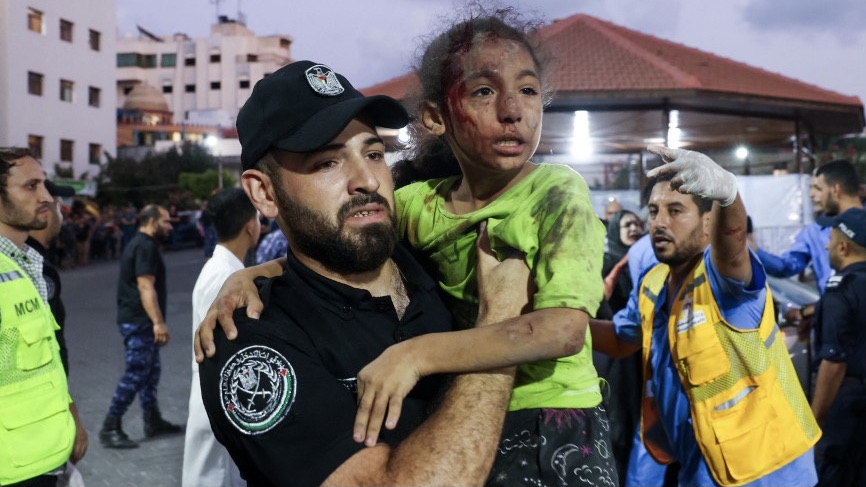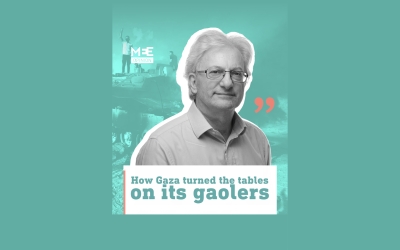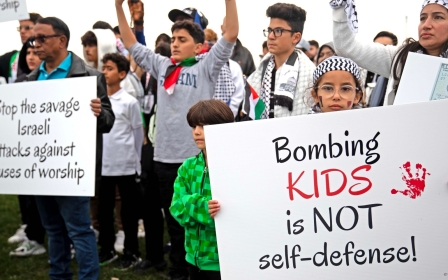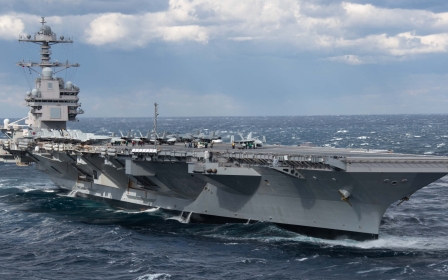Israel-Palestine war: For the West's press, context is sacrosanct - except when it comes to Palestinians

Years ago, I carried out an examination of approximately two years’ worth of New York Times and Chicago Tribune coverage of Israeli and Palestinian killings and deaths.
What I found was unsurprising to anyone familiar with the academic literature, which shows remarkable uniformity.
The newspapers covered Israeli deaths more frequently and prominently than Palestinian deaths, despite there being far more Palestinian deaths during the nearly two-year study period.
The papers were also much more likely to source Israelis, regardless of whether Palestinians, Israelis, or both Palestinians and Israelis had been reported killed on a specific day.
Importantly, both news outlets were highly likely to provide an explicit rationale for Israeli violence, frame Palestinian violence as terrorism, and ignore the larger sociopolitical context that drives the conflict.
New MEE newsletter: Jerusalem Dispatch
Sign up to get the latest insights and analysis on Israel-Palestine, alongside Turkey Unpacked and other MEE newsletters
Reportage of casualties associated with the most recent outbreak of violence, which began with a surprise attack on Israel by Hamas on 7 October, seems to be following the same script.
Events are still unfolding, and it will be weeks, perhaps months, before scholars are able to examine western news reportage empirically and systematically.
Anecdotal evidence - based on preliminary analyses of articles retrieved in archive databases - suggests that little has changed since I carried out my study on the Times and Tribune.
Context is crucial
Mainstream western news organisations - including The New York Times, CNN, The Guardian, BBC, USA Today and many others - have privileged Israeli perspectives; highlighted Israeli casualties and humanity at the expense of Palestinian casualties and humanity; disregarded Palestinian voices and grievances; and overlooked the broader context of the conflict.
Most obvious, perhaps, is that reports have framed Israeli violence as a retaliatory act of war and all Palestinian violence, including violence directed at the Israeli military, as terrorism.
Several news reports have compared the 7 October Hamas attacks to al-Qaeda’s 11 September 2001 attacks on New York and Washington, with numerous outlets using the “Israel’s 9/11” descriptor in headlines.
Follow Middle East Eye's live coverage for the latest on the Israel-Palestine war
The implications of this kind of framing are clear: Israel is at war, its violence is retaliatory and legitimate, and Palestinian violence is barbaric and senseless.
The avoidance of context is particularly crucial. A person who exclusively follows mainstream western news might be tempted to conclude that Palestinians are predisposed to violence, that they wake up and decide to kill.
I, like many journalism and media instructors, have often taught students, both Arab and American, the importance of context to the writing of any news story and especially of stories involving layered histories and events.
Without context, I’ve explained, vital meaning can be lost.
Journalistic social responsibility
Interestingly, in delivering lessons about context, I’ve relied almost exclusively on western journalism manuals and scholarly writings. Indeed, the western news tradition deserves credit for ushering in the notion of journalistic social responsibility, which emphasises the absolute necessity of context for understanding.
Given its centrality to the western journalistic tradition, it is peculiar that context is almost completely ignored in mainstream western coverage of the Israel-Palestine conflict, a point which has been made repeatedly over decades by media scholars. Northwestern University’s Marda Dunsky once argued that the lack of context in US coverage of the conflict represented a type of “bias implicit in the absent”.
Reportage since 7 October has again ignored vital background and context.
For starters, mainstream western reports have made infrequent mention of Israel’s occupation of Palestinian territories, with almost no mention of the fact that the occupation is illegal under international law.
In one database, which houses many hundreds of mainstream western news reports published since 7 October, the occupation was scantily mentioned, and I identified just three references to its illegality.
Also, western coverage has largely sidestepped the daily brutality that the occupation inflicts on Palestinian lives and communities, as well as the grim realities associated with life in Gaza. The strip has been under illegal blockade since 2006, and residents have almost no access to clean drinking water. It has been repeatedly described by Human Rights Watch and other rights groups as the world’s largest "open-air prison".
Recent western news reports have also ignored the inhumane treatment of Palestinian captives, including more than 1,000 Palestinians held without charge in administrative detention.
B’Tselem, the leading Israeli human rights group, has described the treatment of Palestinian detainees as “torture", noting that their treatment is “cruel, inhuman and degrading” and a “blatant violation of international law”.
Subtly legitimising attacks
Even essential context from the past few months has been largely disregarded by most western reporting about ongoing events, despite its direct link to the recent outbreak of violence.
Ignored by western news outlets have been repeated, recent incursions into the holy Al-Aqsa Mosque by Israeli settlers; the recent crime of Israelis spitting at Palestinian Christian worshippers in occupied East Jerusalem; likely war crimes in the West Bank; illegal Israeli settlement expansion on Palestinian land; Israel’s ongoing programme of illegal demolition of Palestinian homes; a spate of terrorist attacks by Israeli settlers on Palestinian villages; and Israeli Prime Minister Benjamin Netanyahu’s erasure of Palestine on a new Middle East map presented last month at the United Nations.
That Israel is carrying out ethnic cleansing and apartheid against Palestinians is not even a controversial point. Amnesty International, Human Rights Watch and B’Tselem have each documented the evidence, as have numerous scholars and analysts.
Mainstream western news coverage has generally avoided these key terms, however.
More than anything, perhaps, Palestinian humanity has been downplayed by mainstream western news media.
Although mainstream outlets have produced reports on Israel’s bombings and the Palestinian casualties they have caused, these stories have tended to downplay the severity of the attacks by subtly legitimising them through a heavy reliance on Israeli sources and an overarching "Palestinian terrorism" frame.
More than anything, perhaps, Palestinian humanity has been downplayed by mainstream western news media
For example, a 10 October report published in USA Today used a headline - “Israeli bombing kills hundreds” - that highlighted Palestinian loss of life.
However, the first source cited in the report is the Israel Defense Forces (IDF), mentioned in the report’s second sentence.
The IDF-provided information highlighted the fact that “Hamas militants crashed through a barrier and launched an invasion that saw over 1,000 Israelis killed or kidnapped”.
The first mention of Palestinian casualties comes in the article’s fourth sentence and is sourced by an Israeli lieutenant colonel, who “said the bodies of 1,500 [Palestinian] militants were found around southern Israel”.
Overall, the report relied on four Israeli sources compared with just two Palestinian sources.
Palestinian dehumanisation
Also, consistent with past reporting associated with earlier waves of violence in the conflict, far more emphasis has been placed on Israeli mourning, sadness and fear than Palestinian. When the dust settles on the empirical analyses, there is almost no question that there will be more such images of Israelis than Palestinians, and this will be despite an inevitably far greater Palestinian death toll.
The CNN Instagram account, followed by nearly 20 million people, provides a useful illustration.
Between 7 October and 10 October, CNN’s Instagram ran a total of 23 posts about Israel-Palestine. Nearly all of them were Israel-centric and highlighted either Israeli self-defence, Israeli casualties or Palestinian violence, as the thumbnail headline texts make clear.
Guiding headline thumbnail texts included: “Horrific scene at town in Israel”; “Hamas militants throw grenade at bomb shelter”; "Reporter takes cover at Israeli airport”; “Video appears to show Israeli woman taken hostage”; “Israeli mother of missing son sends message to Hamas”; “Gaza militants attack music festival, take hostages”; “Festival goer’s harrowing experience running from attack”; “Blinken: US verifying reports of Americans dead and missing in Israel”; “Man says video shows Hamas take his family”; “Rocket lodged in ceiling of Israeli apartment building”; “How Israel’s Iron Dome works”; “Netanyahu says the retaliation in Gaza is just the beginning”; “Iron dome intercepts missile attack”; “Families of missing Americans share last communications”; “Origins of Hamas and its connection to Iran”; and “CNN’s Clarissa Ward takes cover from nearby rockets”.
Only three of CNN’s 23 Instagram posts dealt with Israeli-perpetrated violence in Gaza: “Gaza towers collapse after explosion”; “New explosions seen over Gaza”; and “Israeli airstrike hits refugee camp in Gaza”.
CNN is not alone in delivering this sort of lopsided disparity. Nearly identical news scripts are being followed on mainstream western television networks, newspapers and social media accounts in the United States, United Kingdom, and elsewhere in the western world.
In the sort of best-case scenario western reports, news consumers are presented with a kind of misguided balance - they are given apparent suggestions that the violence in Israel-Palestine is essentially tit-for-tat.
If the context tells us anything, however, there is nothing tit-for-tat about this conflict.
There is an occupier and an occupied. There is an apartheid state, on the one hand, and a stateless people, on the other. There is an ethnic cleanser and a people being ethnically cleansed. There is a clear aggressor and a clear victim.
Here’s to hoping that mainstream western journalism someday gets it right. Palestinian humanity is depending on it.
The views expressed in this article belong to the author and do not necessarily reflect the editorial policy of Middle East Eye.
This article is available in French on Middle East Eye French edition.
Middle East Eye delivers independent and unrivalled coverage and analysis of the Middle East, North Africa and beyond. To learn more about republishing this content and the associated fees, please fill out this form. More about MEE can be found here.







